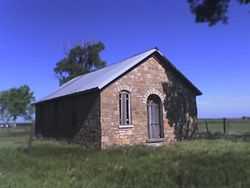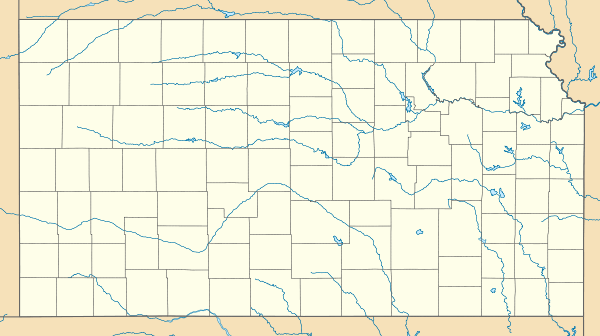Silkville, Kansas
|
Silkville | |
 | |
|
Silkville's school | |
 | |
| Location | Williamsburg Township, Franklin County, Kansas |
|---|---|
| Nearest city | Williamsburg, Kansas |
| Coordinates | 38°27′00″N 95°29′21″W / 38.45000°N 95.48917°WCoordinates: 38°27′00″N 95°29′21″W / 38.45000°N 95.48917°W |
| Area | 6 acres (2.4 ha) |
| Built | 1870 |
| Governing body | Private |
| NRHP Reference # | 72000504[1] |
| Added to NRHP | December 15, 1972 |
Silkville is a ghost town in Williamsburg Township, Franklin County, Kansas, United States. Its elevation is 1,161 feet (354 m), and it is located at 38°27′0″N 95°29′21″W / 38.45000°N 95.48917°W (38.4500149, -95.4891477),[2] along U.S. Route 50 southwest of Williamsburg.[3]
History
The settlement was established in 1870 by Frenchman Ernest de Boissiere. Because Boissiere had been born into a noble family and had political inclinations opposed by France's then-ruler Napolean III, he was forced to flee. Boissiere first spent time in New Orleans before traveling to Kansas; he concluded that the state afforded him both the potential to practice his ideas and create the type of community he desired. Boissiere then purchased 3,500 acres of land in the county from the Kansas Educational Association of the Methodist Episcoal Church in 1869. Silkville was intended to be a utopian commune that survived via silk production; Boissiere initially structured the system so that remuneration was based on the proportion of production for each settler. The settlement went under myriad different names, including Kansas Cooperative Farm, Prairie Home, and Valeton. Boissiere arranged for 40 French emigrants to settle the colony in the early years. Although the community initially prospered, many members left to join mainstream society.[4]:2 To compensate Boissiere, shifted production towards butter and cheese, and later stock raising. And while this was fairly successful for a while, the community eventually collapsed and dispersed. The property was given to the Independent Order of Odd Fellows for use as an orphanage. Financial reasons compelled the Order to give up the property, and after a long court battle, it passed into the hands of lawyers from Topeka.[4]:3:5
Remains
Today, little remains of Silkville. Many of the original buildings were destroyed by a 1916 fire, and only three stone structures survive: the settlement's school house, and two barns.[4]:2 The original chateau that Boissiere constructed—which, at the time of its construction cost $10,000—was destroyed in the aforementioned fire, and a modern home was built over the west end of the ruin, utilizing some of the stone from the original.[4]:2:3 In 1972, these buildings were added to the National Register of Historic Places under the name of "Silkville," because of their significance in the history of Kansas.[1] The aspects of the community seen as most significant historically were its nature as an intentional community and its practice of sericulture.[4]:5
References
- ↑ 1.0 1.1 "National Register Information System". National Register of Historic Places. National Park Service. 2009-03-13.
- ↑ U.S. Geological Survey Geographic Names Information System: Silkville, Kansas
- ↑ DeLorme. Kansas Atlas & Gazetteer. 4th ed. Yarmouth: DeLorme, 2009, 52. ISBN 0-89933-342-7.
- ↑ 4.0 4.1 4.2 4.3 4.4 Pankratz, Richard. National Register of Historic Places Inventory/Nomination: Silkville. National Park Service, 1972-05-15. Accessed January 31, 2010.
Further reading
- "Mons. E.V. Boissiere's Silk Factory — A Magnificent Enterprise". Ottawa Journal, 1871-06-01.
- Nordhoff, Charles. The Communistic Societies of the United States. New York: Harper, 1875, 375-382.
| ||||||||||||||||||||||||||
| |||||||||||||||||||||||||
